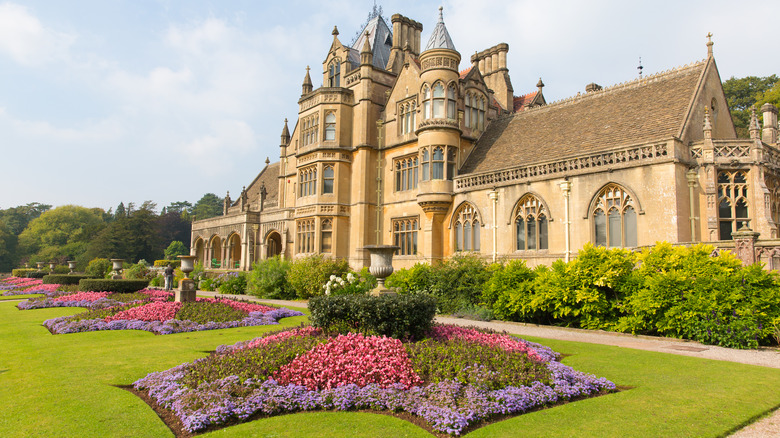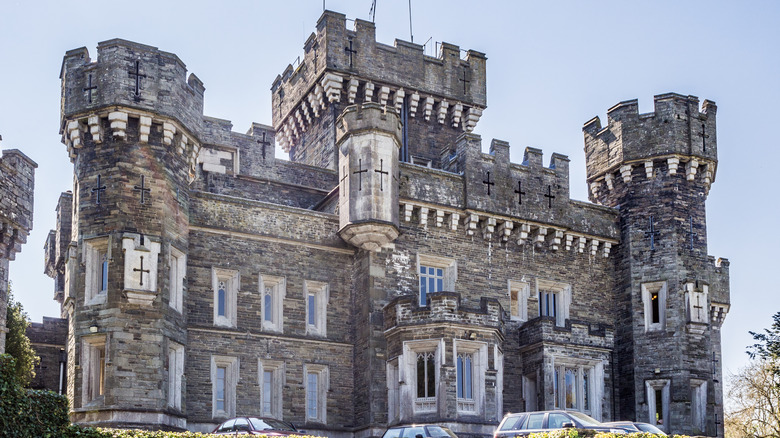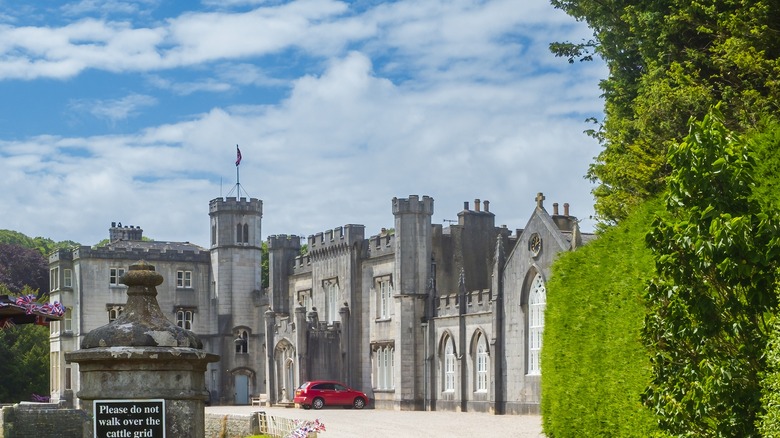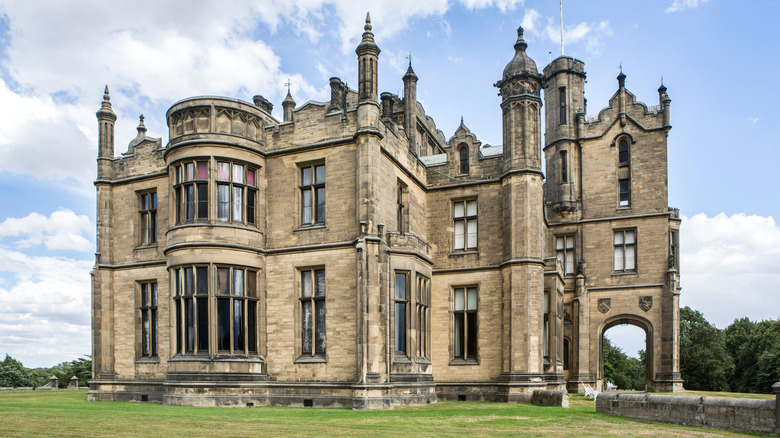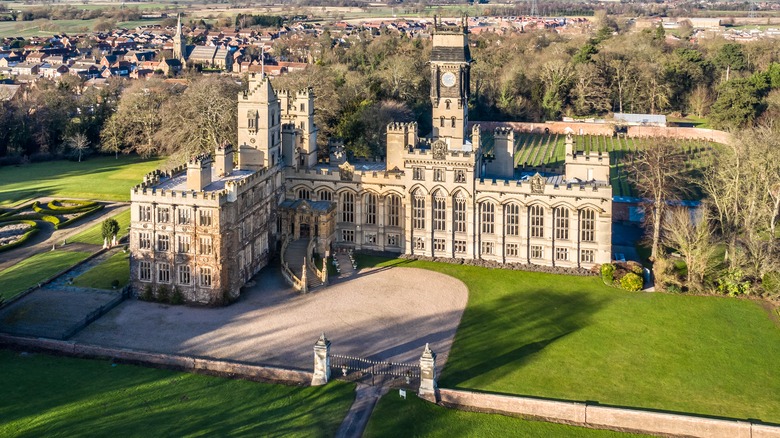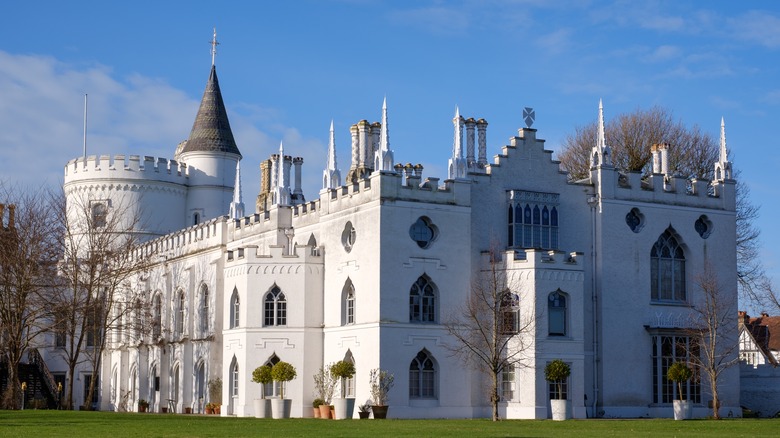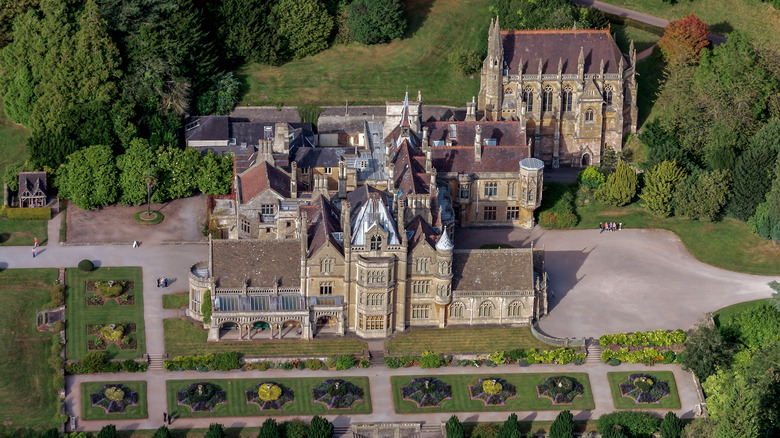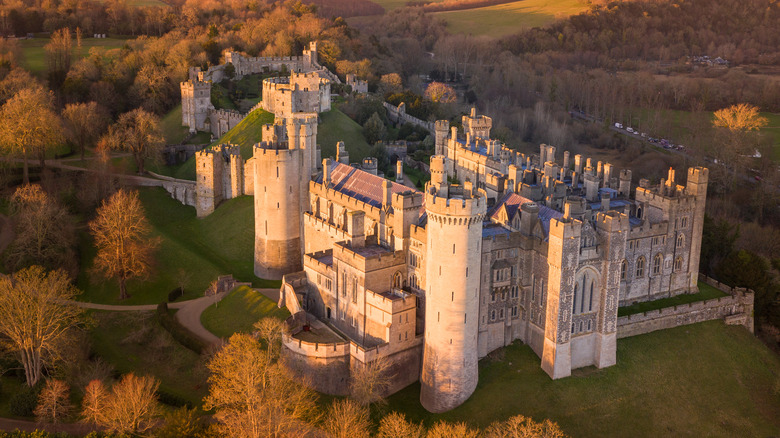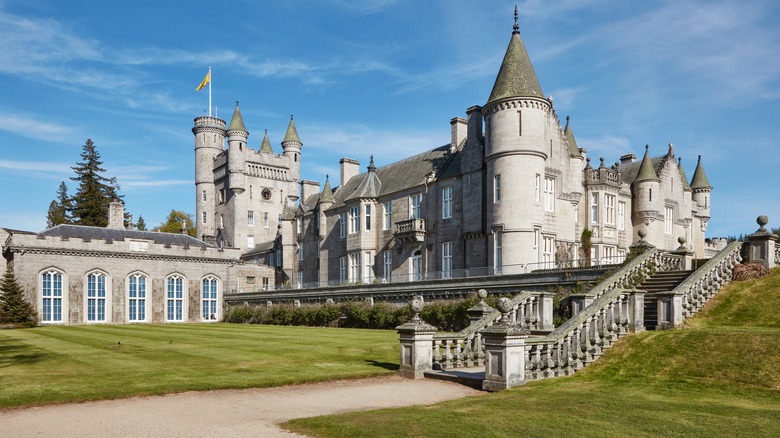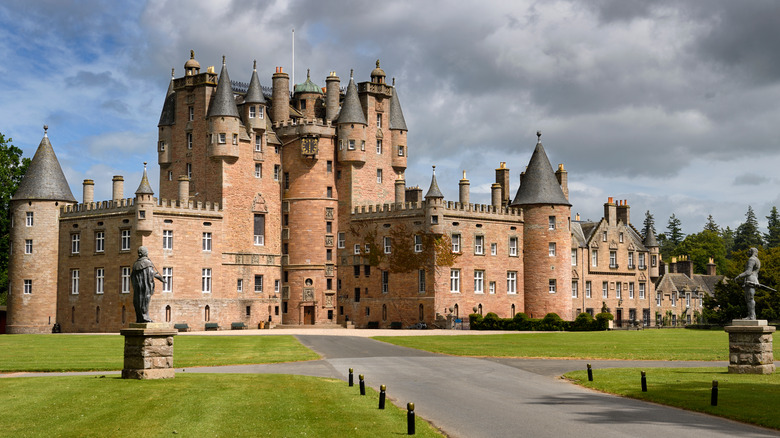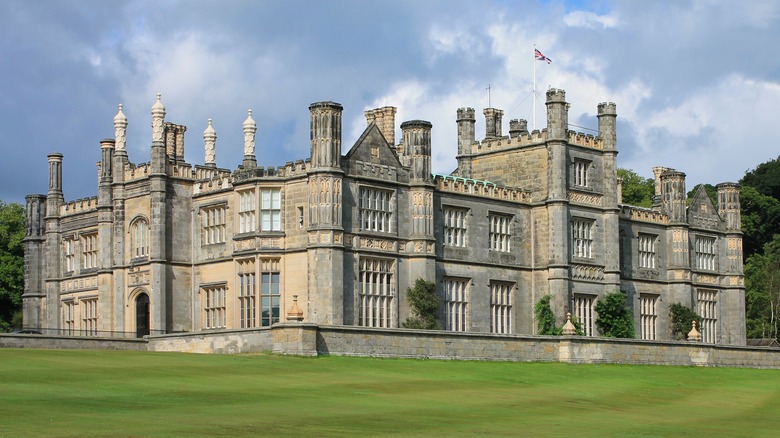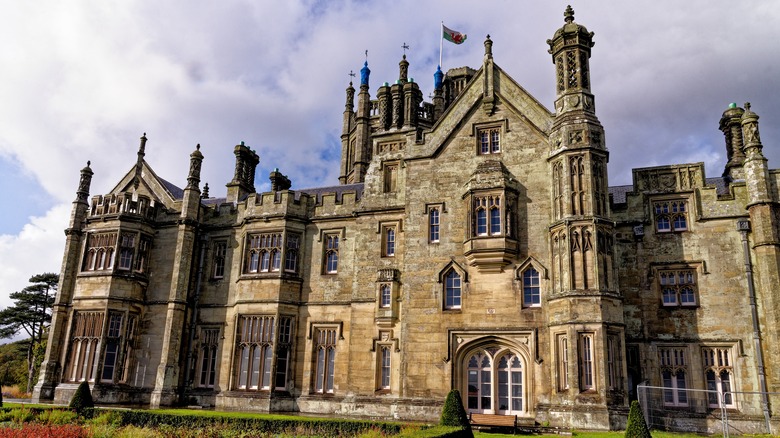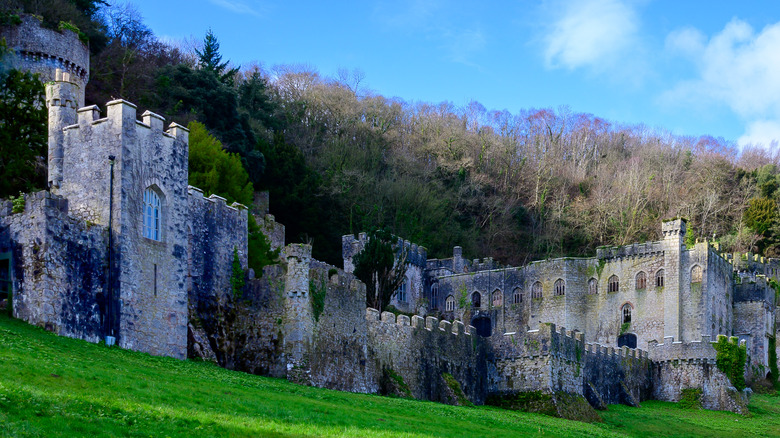Stunning Gothic Castles You'll Want To Visit On Your Next Trip To The UK
"Gothic" describes a 6th-century Germanic culture, a style of architecture first popularized in the 12th century, and non-conformist teenagers from the 1990s. Back in the 12th century, the word wasn't meant to be flattering — modern medieval architects who were critical of pointy arches, big windows, and flying buttresses tagged the style with the word "Goth" because they thought the nomadic Goths and the new architecture were equally barbaric (via Revisiting History). Today, we beg to differ. Gothic architecture is so admired that people still incorporate elements of it into modern buildings.
Even so, examples of early Gothic castles are scarce, especially in the United Kingdom, mostly because medieval kings were forever trying to usurp each other, and their castles got knocked down a lot. (Good examples of old Gothic are easier to find in churches and cathedrals, which did not tend to get attacked so much). This is why most of the "Gothic" castles that still exist in the UK are "Gothic Revival." "Gothic Revival" refers to Gothic-style buildings built in the Victorian era; you will also hear the term "Neo-Gothic," which is sometimes used interchangeably with Gothic Revival and sometimes to specifically describe Gothic-style buildings built in the 20th century or later, like Liverpool Cathedral (via Ace Mentor Program).
To compile this list, we picked some of the most beautiful Gothic castles in Scotland, England, and Wales. We heavily favored those that are easy to visit and tried to include a mix of styles and eras.
Wray Castle, Cumbria, England
Wray Castle on the banks of Lake Windermere in Cumbria is an example of a 19th century Gothic Revival castle. It was built by a surgeon and his wife, who was heir to a gin fortune, so it's not really a "castle," at least not in the fortified, "ancient seat of an earldom" sense of the word (via Lake District Gems).
Wray Castle features many of the architectural details that were popular during the Gothic Revival period, including pointed arches and ribbed vaults. The castle's architect actually went a little overboard with the design — it has fake arrow slits (even though the castle really hasn't ever been in danger of besiegement), turrets that you can't actually stand on, and fake ruins on the grounds because, you know, ruins are cool. According to Visit Cumbria, the gin-fortune heiress who paid for the castle's construction hated the finished building so much that she decided not to live there.
Today the castle is owned by the National Trust, and has been open to visitors since 2011. You can explore the castle's interior, the arboretum, and the Gothic boathouse and jetty (the latter offers Windermere Lake cruises in the spring through early fall).
Leighton Hall Estate, Lancashire, England
Like so many other British castles, the history of Leighton Hall is long but the castle itself is practically new. There was a fortified manor house on the site as far back as 1246, and in 1715 the castle was burnt by government troops because it was owned by a man who supported the Jacobite rebellion (via Britain Express). The Gothic Revival-style castle as it is today wasn't built until the 19th century. According to Heritage, the existing castle was kind of just stuck onto the sides of the 18th-century structure that replaced the original medieval castle. The current Gothic facade features stonework, pointed arches, and other Victorian Gothic features that will make you think you're visiting a medieval castle, even though technically, you're not.
Leighton Hall is a fun and friendly tourist destination because visitors aren't sequestered behind velvet ropes and herded through by an underpaid docent who hates her job. The estate is still a family home, and visitors are treated like guests, not tourists. In fact, the castle's official website promises that no one will be yelling at children not to touch anything, which is pretty rare in the world of historic house tourism. Britain Express says visitors are encouraged to sit on the furniture and make themselves at home at the 18th-century table. You can even play the Steinway Concert grand piano, though please have mercy on the rest of us and don't just poke mindlessly at the keys.
Allerton Castle, North Yorkshire, England
Allerton Castle is Grade I on the National Heritage List for England, which means it's a building of "exceptional interest." According to Historic England, only 2.5% of the UK's listed buildings are in this category, so if you're in Britain and you find yourself having to choose between Gothic castles, you might want to make sure Grade I buildings like Allerton are on your list of must-dos.
This huge 45-bedroom Gothic Revival castle is the ancestral home of Lord Mowbray, Segrave, and Stourton and has been featured in a few movies and TV shows you might have seen, including "The Secret Garden" and "Lost in Austen." Noble families of old seemed to enjoy tearing down and replacing historic buildings, so most of the original house was already gone by the time the 19th Baron of Stourton decided to rebuild in 1848. The builders did try to use the original materials in the new construction, and one record says part of the castle was built around some of the original house. Apparently, the old dining room also survived, though it was given a different purpose.
The great hall alone makes a visit worthwhile. According to Atlas Obscura, the room has 80-foot ceilings, stained glass windows, and Gothic oak woodwork. Check the website before you decide to visit, as tour schedules were not posted as of late 2022.
Carlton Towers Estate, East Yorkshire, England
Historic Houses refers to the Carlton Towers as an extravagant and fanciful Gothic-themed adventure, so if that's not a recommendation, we're not sure what is. Erected in 1614, the original three-story building still stands, and the exterior walls are covered with a fabulous sheet of climbing ivy. That wing is in stark contrast to the newer, much bigger wing, which was added around 1777 and features an enormous clock tower that looms over everything else on the grounds.
The Gothic facade was added by the 9th Lord Beaumont, who wanted the already impressive house to be an even more impressive Victorian country house, which seems to be an understated phrase, but whatever. Beaumont's architects added battlements, turrets, and gargoyles (what country house doesn't have those?) and redesigned the interior with Gothic touches like carved woodwork and gilded ceilings. Today, the castle's many rooms contain some of the best-preserved examples of the Gothic Revival style.
Carlton Towers is also a Grade I historical building, but that doesn't mean that everyone who's ever visited has been impressed. In 1939, "man of letters" Evelyn Waugh wrote that the house was "staggering," and not in a good way. He mentioned the excessive space, harsh lighting, and squished-together arches and windows (via Evelyn Waugh Society). On this one, you should probably just decide for yourself.
Strawberry Hill House, Twickenham, England
Perhaps more than the other houses on this list, Strawberry Hill looks like a Gothic-inspired modern home, and that's roughly accurate. The house does date back a little too far to be entirely "modern" — it was built in the mid-1700s by writer Horace Walpole (author of "The Castle of Otranto," the world's first Gothic novel). Instead of featuring the bare, gray stonework of other Gothic-style castles, the exterior of Strawberry Hill House is painted clean, bright white. This gives the house the look of a castle but the ambiance of a much more modern home.
Strawberry Hill's history is unlike the histories of similar Gothic-style homes, which tend to be built on heraldic lands by noble families. Walpole didn't inherit "Chopp'd Straw Hall," he bought it, largely because it was a nice piece of land on the Thames. As the world's first Gothic novelist, he clearly needed a Gothic castle to live in, so he modified the existing cottages into a stately home featuring battlements, pinnacles, and a round tower (via Strawberry Hill House).
Walpole wasn't just a man of literary innovation, he was also a British tourism pioneer. The aristocracy was intrigued by Walpole's weird house and its art and antique collection, so he had his housekeeper charge a guinea to take visitors on tours (via Regency History). At the time, a guinea was worth around £125 in modern money (via National Archives) — fortunately, today's tours are considerably less expensive.
Tyntesfield House, Bristol, England
If you want to see old-style Gothic architecture in England, your best bet is to visit one of the Gothic cathedrals, which remain largely as they were when they were built hundreds of years ago. As far as castles go, though, you won't get much closer to old-style Gothic than Tyntesfield. Technically, this is a Gothic Revival castle but it features many cathedral-like features, such as gothic windows and turrets, pointed arches, and asymmetrical construction.
Tyntesfield was built in the mid-1800s by William Gibbs, who made his fortune from ... seagull poop. Yes, in those days seagull poop (properly known as guano) was a prized fertilizer, and those who could overcome the grossness factor long enough to scoop it up and put it in bags actually became rich. Gibbs exported guano from the Chincha Islands off the coast of Peru and eventually became so wealthy that he was able to turn Tyntesfield into the extravagant Gothic castle it is today (via National Trust). He probably didn't even mind when the locals sang their little ditty about Gibbs, dibs, and turds of foreign birds. Bet you'll never look at seagull poop the same way again.
Today, Tyntesfield is open to the public, and you can also wander around the woodland and orchard, visit the Gothic chapel, and even let your kids play in a den-building village. There's also a garden, a shop, and a cafe.
Arundel Castle, West Sussex, England
Arundel Castle is an old, old building. So old, that one of the things it's most famous for is housing Empress Matilda when she was warring with her cousin Stephen for the British throne, more than 400 years before England had its first official Queen Regent (Mary, the bloody one). Even so, Arundel is yet another example of Gothic Revival architecture, though its Norman and medieval origins are still evident.
Arundel Castle was heavily damaged during the English Civil War in the mid-1600s, but it wasn't until the late 1700s that any real effort was made to repair it. Over the next couple of centuries, the castle got a series of Gothic upgrades, including a Gothic music gallery with a painted-glass window, and a double-return staircase with a Gothic balustrade (a fancy word for railing, in case you don't speak architect). In 1875, the 15th Duke of Norfolk enlisted an architect to complete the bulk of the remaining Gothic upgrades, including ribbed vaults and Gothic chimneys (via British History).
Arundel Castle opens to the public every April and continues to offer tours through the summer and fall. When you're done exploring the castle, you can lose yourself in the lavish gardens, visit the gift shop, or have a cappuccino with some shortbread in the castle coffee shop (via Arundel Castle).
Balmoral Castle, Aberdeenshire, Scotland
Balmoral Castle in the Scottish Highlands is a beautiful example of Scottish Baronial architecture, which is a Gothic Revival style particular to early 20th century Scotland. This style is asymmetrical, featuring steeply pitched roofs, stone exteriors, conical towers, and crenellations (those toothlike shapes that ring the tops of battlements).
There's been a structure on the site of Balmoral Castle since the 1300s when the Scottish King Robert II had a hunting lodge there (via Castrum to Castle), but the castle itself wasn't completed until 1856, a few years after Prince Albert bought the estate as a gift for Queen Victoria. The castle's most stunning feature is its clock tower, which is turreted and features fairy-tale towers reminiscent of the ones you'll see in the Cinderella Castle at Disneyland.
Today, Balmoral is still owned by the royal family, in fact, it is the death place of Queen Elizabeth II, which means visiting the estate is not the same experience it used to be. Because this is a royal residence, much of the castle itself is off-limits to the public (via Secret Scotland), though you can visit the very-Gothic grand ballroom. The castle's official website also says you can book tickets for a "Balmoral Expedition," which takes you on an extended tour of the castle grounds and surrounding area.
Glamis Castle, Angus, Scotland
Glamis Castle in Scotland is not only architecturally Gothic, it's also got that dark Gothic novel vibe and some possibly-fabricated history to back it up. According to Smithsonian, in the mid-1800s, rumors began circulating that the castle had a secret room and that someone was imprisoned in it, possibly the heir to the Earldom, possibly kept there because he was horribly disfigured. It was probably just a rumor, but today Glamis is said to be the most haunted place in Scotland. And because it's dumb for historical places to not capitalize on the ghost-hunting craze, you can book an adults-only ghost tour of Glamis Castle around Halloween time.
There's been a castle on the property for at least 1,000 years, but construction on the current castle began in 1400. Though Glamis still has the bones of the original castle, it's considered an example of Gothic Baronial architecture (via Clan Lyon). The exterior features turrets and spires and the interior is full of typical Gothic touches like stained glass, oak paneling, and pointed arches (via Historic Environment).
Like many of the UK's historic attractions, Glamis Castle closes in the winter and reopens in the spring. During the on-season, you can book a tour of the house, explore the gardens, or eat at the castle kitchen.
Dalmeny House, Edinburgh, Scotland
Dalmeny House is a latecomer, as far as castles go. It was completed in 1817 and is considered a "Tudor Gothic" style mansion, though it definitely has the appearance of a castle. Dalmeny house was designed by William Wilkins, the same guy who designed the National Gallery in London. The castle was the first home in Scotland to be built in a Gothic Tudor style, featuring octagon-shaped towers and carved chimney pots, which are very similar to what you'll see at Hampton Court Palace, Henry VIII's most famous residence.
Dalmeny's interior is considered Regency style, though stained-glass windows and fan-vaulted corridors help the interior retain some of that Gothic ambiance. The great hall also has a very Gothic hammer-beam roof (via Scottish Places), and the whole place is stuffed full of art and antiques. There's even an entire room devoted to Napoleon Bonaparte memorabilia.
Dalmeny House is still a family home, so you can't wander around with abandon and you can only visit at certain times of the year, typically summer, when guided tours through the house are offered. As of late 2022, however, Dalmeny House was still closed for renovations and COVID-related reasons (via Rosebery Estates).
Margam Castle, Port Talbot, Wales
Margam Castle's history goes a long, long way back — according to Herald Wales, there's a herd of deer living on the grounds that was probably introduced by the Romans. Until the dissolution there was an abbey on the site; after that various houses were built, demolished, and rebuilt. Finally, in the late 18th century, the house was rebuilt yet again in the Tudor Gothic style for Christopher Rice Masel Talbot, popularly known as Britain's "wealthiest commoner." Talbot was a politician who was also fabulously rich, largely due to some smart investments in Britain's burgeoning railroad industry. According to Britain Express, Margam castle and its Gothic gables, battlements, turrets, and towers cost around £50,000 to build, which is a few million in today's money.
The house stayed in the Talbot family until 1942, but the next owner declined to move in, and the castle began a slow decline into rubble. In 1973, Glamorgan County Council bought the home and estate with the intent to open it to visitors, but just a few years later a fire gutted the interior. Restoration at Margam Castle has been going on for decades, and still isn't considered complete.
Today, Margam Castle Park is a Grade I historic site and is open to the public. You can visit the castle and grounds or book your wedding at the Orangery and Gardens. Hen Eglwys, a ruined chapel, sits at the western edge of the park (via Margam Castle Park).
Gwrych Castle, Abergele, Wales
If you had to guess, you'd probably say Gwrych Castle was a very old, very abandoned castle. From a distance, it looks like a ruin, but it's actually a working tourist attraction that you could stay overnight in, you know, if you dare.
Gwrych Castle is also not that old. One Lord Hesketh began construction on the sprawling Gothic Revival castle in 1819, but 75 years later the property changed hands, then it changed hands again ... and again. Over the years, Gwrych has been a home for Jewish refugees, a jousting venue, and a movie set, but no one really maintained it and by the 1990s it was starting to fall apart (via Atlas Obscura).
Today, Gwrych Castle with its towers, turrets, pointed arches, and stained glass windows is considered a Grade I property. It's owned by a preservation trust and is still undergoing the long process of restoration, but it is possible to tour the grounds and even stay in the Tan-yr-Ogo Lodge, which was at one time the ceremonial entrance to Gwrych Castle. The property also hosts monthly ghost hunts, so you should probably think carefully before you decide if you really want to stay in Tan-yr-Ogo or not.
